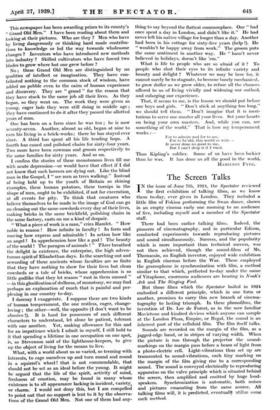The Screen Talks
TN the issue of June 7th, 1924, the Spectator reviewed -I- the first exhibition of talking films, as we know them to-day, ever given in London. They included a little film of Fokina performing the Swan dance, shown in an empty cinema early one morning to an audience of five, including myself and a member of the Spectator staff.
There had been earlier talking films. Indeed, the pioneers of cinematography, and in particular Edison, conducted experiments towards reproducing pictures and sound simultaneously. Success, and the popularity which is more important than technical success, was not then achieved, though the sound-films of Mr. Thomassin, an English inventor, enjoyed wide exhibition in English cinemas before the War. These employed the gramophone in synchronization with film, a method similar to that which, 'perfected to-day under the name of Vitaphone, enormous audiences are hearing in Noah's Ark and The Singing Fool.
But those films which the Spectator hailed in 1924 embodied a different principle, which in one form or another, promises to carry this new branch of cinema- tography to lasting triumph. In these phonofilms, the invention of Dr. Lee de Forest, as in the now familiar Movietone and kindred devices which anyone can sample at the London Plaza, Empire, or Regal, the sound is an inherent part of the celluloid film. The film itself talks.
Sounds are recorded on the margin of the film, as a jagged-edge band, or in stripes of varying width. When the picture is run through the projector the sound- markings on the margin pass before a beam of light from a photo-electric cell. Light-vibrations thus set up are transmuted to sound-vibrations, each tiny marking on the margin of the film giving rise to a corresponding sound. The sound is conveyed electrically to reproducing apparatus on the valve principle which is situated behind the screen, then amplified and emitted by huge loud- speakers. Synchronization is automatic, both noises and pictures emanating from the same source. All talking films will, it is predicted, eventual/I utilize some such method. - The fihn induitry itself; poiveiful and wealthy though: it be, and deeply affected as it is by the' introduction of sound into cinematography, was not responsible" for talking pictures. Dialogue and sound with films were forced on them by inventions perfected by the great electrical companies. It is the Western Electric and Radio Corporation across the Atlantic, Siemens and the General Electric in Europe who are bringing the innova- tion about. The film industry was compelled to harness . this new factor, or find -itself in competition as purveyors of mechanically reproduced entertainment with the electrical wizardry of two continents.
The comparatively humble firm of Warner Brothers,- of Hollywood, actually popularized the talking picture,: alMost by accident, for they were not first in the field They produced a picture which will go down to history, The Jazz Singer, followed by a companion, The Singing Fool. These two films earned the company, which had been in financial straits, a vast fortune. Still more important, they set cinema proprietors all over the world (and it is they who control the film industry) asking for talking films, because it seemed there was much money to be made by showing them. That The Singing Fool, shown as yet - in fewer than a 'dozen cinemas in Great Britain, has been seen and heard by over two million people is sufficiently significant.
To-day certain big studios in Hollywood are making nothing but talking pictures. English and German film companies are following suit. Cinemas,. both in England and Ameriea, find their takings increase by over twenty per cent. when they show talking pictures. Even Paris has provided huge audiences for The Singing Fool.
It is impossible not to speculate already on the possi- bility of English becoming a world-language through the screen. It would be absurd to overlook the oppor- tunity which this new type of entertainment offers our English film makers. If it is seized, at the very least picture theatres throughout the English-speaking world, and quite possibly further Add still, may enjoy, and pay to enjoy, a composite form of entertainment emanat- ing from London and uniting some of the qualities of the best silent films with those of the theatre, the operatic stage and of wireless : not revenue alone will accrue, but that prestige for England of which all well-wishers to the British film revival dream.
Here in London are potential riches such as even Hollywood never dreamed of : it is not only our play.. wrights, our actors, broadcasting artists and technical eiperts, and our electrical engineers who comprise this wealth. London easily draws to itself the great personal- ities in all the arts and professions in Europe. PerhaPS more important, there is the English speaking-voice, and the English tradition and culture. IRIS BARRY.









































 Previous page
Previous page